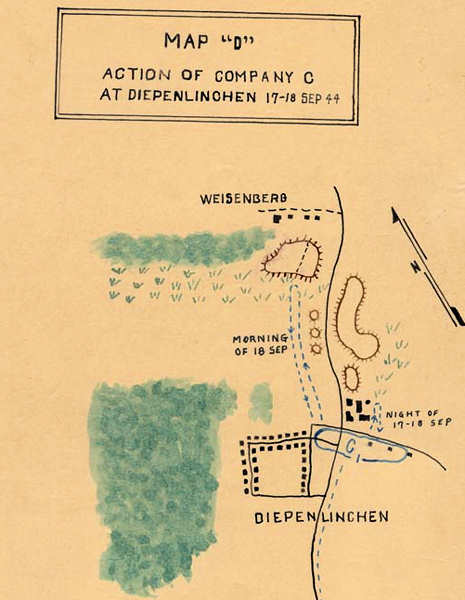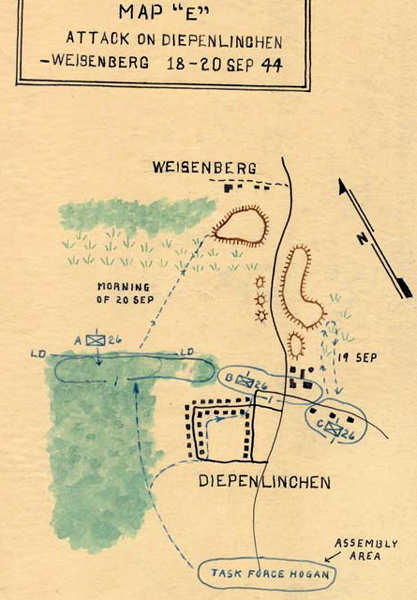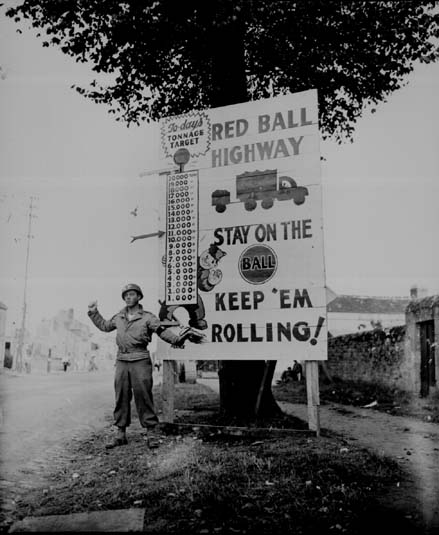(1st Infantry Division) during the initial penetration
of the Siegfried Line in the vicinity of
Nütheim, Germany, 13 - 20 September 1944
(Rhineland Campaign)
The Attack at Diepenlinchen
By Captain Armand R. Levasseur
At 1700 hours Company C was detached from the battalion and sent on a separate mission at Diepenlinchen, three miles to the northeast, arriving at the designated assembly area at 1900 hours. (See Map C) There the company commander was briefed by the staff of Combat Command B, to which he was attached, on the current situation. A battalion of the 36th Armored Regiment had been driven from the objective, the high ground southwest of Weisenberg, during the afternoon by an enemy counterattack. Elements of this battalion, having been cut off, were believed to be holding out on the objective. This could not be confirmed as no contact had been made in several hours. Company C's mission was to establish contact with these elements, evacuate any wounded men found enroute, and recover weapons abandoned on the position at the time of withdrawal.
At 2000 hours Company C started forward with a platoon of tanks attached. The head of the column had reached a position immediately southwest of Diepenlinchen when a strong enemy outpost or patrol of approximately 35 men was encountered. As the column halted to investigate, the enemy opened fire with automatic weapons. Due to the difficulty of control in extreme darkness over unknown ground, the company commander deemed it unadvisable to attempt further advance during the night. The company withdrew and took up positions at the southwest edge of Diepenlinchen. (See Map D)

MAP D
During the night the company commander made a thorough map reconnaissance and at dawn the company renewed the advance, this time by skirting Diepenlinchen around the northwest across open ground. The attached tanks remained at the line of departure to avoid giving the enemy advance notice of the attack. A heavy fog which concealed the column suddenly lifted as the point reached a position just short of the objective, a high bluff rising sharply to a height of 50 feet. Down a trail leading through the center of this bluff a company of enemy was observed advancing to counterattack. To avoid a meeting engagement with a force that had the advantage of high ground, the company commander ordered a delaying action. The withdrawal was proceeding in an orderly manner when enemy automatic weapons opened fire from the right flank, cutting off the point squad together with the company commander. The balance of the company retired to positions occupied during the night and prepared to meet the enemy attack. 052366 (35)
Meanwhile, back in the town of Busbach, Task Force Hogan (minus) was being relieved by another unit and at 1035 hours on 18 September this force reached the designated assembly area and was organizing for an attack. (See Map C) 36
Unit commanders were advised that Company C had been attacked by a heavy force, had suffered many casualties, and had lost the area around Diepenlinchen as well as failing to take the objective at Weisenberg. Many casualties had been evacuated but small groups were believed holding out in positions in Diepenlinchen after being cut off. 37
Company B, with several tanks attached, would lead the attack. The infantry was to advance under cover of the woods on the left flank while the tanks would proceed up the road. On reaching the edge of town the infantry was to emerge from the woods, join the tanks and launch a coordinated attack through Diepenlinchen. Company A was to follow Company B until the latter left the woods to join the tanks, at which time it would continue northeast through the woods to the further edge and there take up positions to secure the left flank of Company B. (See Map E)

MAP E
As the infantry reached a point in the woods opposite the outskirts of town the tanks were echeloned to their right. The infantry-tank team launched its attack under scattered small arms, mortar and artillery fire. Tanks covered the infantry by direct machine gun fire into all buildings as the infantry worked from house to house. By darkness the attack had cleared the town and reached the factory district, taking 49 prisoners enroute. Defensive positions were organized for the night, Company B tying in with Company A on its left flank. Elements of Company C were contacted throughout the day and a count taken in the evening indicated that battalion casualties for the day totaled 115. (38)
Shortly after dark an enemy counterattack developed on Company A's open left flank which threatened the rear of the battalion position. The Ammunition and Pioneer Platoon was thrown in on the left to cover this flank and the attack was beaten off one hour later. (39)
The critical condition of the supply system became apparent during the day when Lieutenant Phillips, commanding the 81-mm mortar platoon, received word that ammunition was not available at the army dump to replace his exhausted stocks. This was brought to the attention of the division commander and within 24 hours a 2½-ton truck load arrived on the mortar position, direct from Paris via the Red Ball Express. This represented a distance of over 200 straight line miles. (40)

On the following day, 19 September, shortly after daylight, Company B continued the attack in the factory area. However, due to deadly enemy fire at close ranges from behind a maze of thick walls and numerous supporting pillars, coupled with difficulties of control, progress was very slow. (41)
As a result, the task force commander decided to try a right flank envelopment. Company A, with a company of tanks attached, would attack at 1200 hours from its present position, seize and defend the high ground in the vicinity of Weisenberg, cutting off Germans in the factory area. (42)
Company A jumped off with two rifle and two tank platoons abreast, leaving the balance of the rifle and tank companies in a concealed position to cover the attack. As the line reached a point midway across the open ground, it came under a concentrated fire from all types of enemy weapons, including 20-mm guns. To quote the words of Lieutenant Colonel Hogan, task force commander, "I never saw such a concentration of German artillery before or since." The infantry pulled back to the cover of prepared positions in the woods and the tanks, having no infantry protection, also retired. (43)
At this time General Boudinot, commanding Combat Command "B", directed the task force commander to effect an envelopment around the right flank of Company B, to seize Weisenberg from the south. The task force commander objected to this plan as he had previously considered the plan but had dropped it when a personal reconnaissance proved the boggy ground was unsuitable for tank maneuver. However, he was directed to attack immediately. (44)
At approximately 1400 hours Company C, with a strength of 62 men, and with four tanks attached, moved out of its reserve position. As the column crossed the open, boggy terrain just south of the factory area it came under heavy mortar, artillery, antitank gun and small arms fire from the east and northeast. The tanks soon were mired in the bog, had to be abandoned, and were destroyed; the infantry was forced to take cover. (45)
It was then decided to make a second attempt to envelop the position from the left flank, to be preceded by a 10-minute barrage from all available artillery in the corps. Smoke would be used to screen Company A's left flank from enemy observation as it crossed the open ground, in the event that the infantry could not keep up with the supporting tanks, the tanks were to continue on alone to the objective, Weisenberg.
Company A was forming on the line of departure as the heavy preparation began. However, many rounds of friendly artillery appeared to be falling short of the target, in fact the concentration searched back toward our line of departure to the extent that Company A was forced to withdraw to covered positions minimizing casualties from overhead tree bursts. After a 30-minute delay to permit registering on the target by all forward observers, the concentration was repeated. Again tree bursts forced the infantry to take cover. The tanks, however, jumped off according to plan and had reached a line just short of the woods (See Map E) when two tanks were destroyed by antitank fire from their left flank and a third was knocked out by a round from a panzerfaust, the German equivalent of our bazooka. Without infantry protection, the remaining tanks retraced their route to the assembly area. (46)
No further attempts were made to take the objective on this day. The task force commander considered the possibility of a night attack that night but the shot up, exhausted condition of the troops prohibited driving home such an attack. (47)
Enemy prisoners captured late in the afternoon stated that a company of German infantry had been forming for a counterattack when our tanks had opened fire on their position in the woods, disrupting the plan. In view of this a counterattack was considered likely on our left flank during the night.
Outposts reported considerable activity to their front but no patrols were encountered. As our troops had suffered considerable casualties and were exhausted, a plan was devised to keep the enemy off balance during the night. The company of tanks attached to Company A were to crank up at midnight, move out in a line to a point half way across the open ground to the front, then cut loose with all guns blazing. At midnight a terrific volume of fire suddenly fell on the target area and continued for five minutes before the enemy could call down his supporting fires, which caused our tanks to withdraw. (48)
A tank-infantry attack with full artillery support was planned for the following day, 20 September; however, at O630 hours an intense fog covered the area, limiting visibility to 50 yards. Plans were changed in view of the possibility of achieving surprise. Artillery preparation was cancelled and tanks were ordered to remain in present positions. Guides were to be sent back to lead the tanks up after Company A had secured the objective. Company A would move across the open ground as had been attempted previously and, in complete silence, attempt to swamp the position before the enemy was aware of the attack. The attack went according to plan. Many of the enemy were overrun as they slept in their foxholes. Thirty-three prisoners were taken as compared to only two casualties suffered by Company A. These prisoners, who appeared completely demoralized, stated that, the sudden heavy tank fire at midnight again had caught them forming for a counterattack and had cut them to ribbons. (49)
Companies B and C were brought up on the flanks to consolidate the position.
On the night of 20 September, at 2130 hours, the 1st Battalion, 26th Infantry was relieved by elements of the 9th Division. It had suffered 229 casualties in the eight days since crossing the German frontier. The battalion moved to an assembly area 1000 yards behind the lines, where the men received a hot meal and some rest, preparatory to a continuation of the attack in another sector on the following morning. (50)
The battalion received the Presidential Unit Citation for this action. (51)

